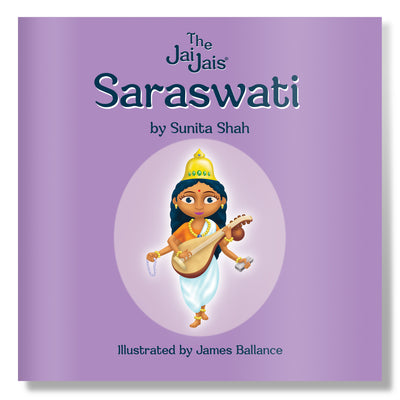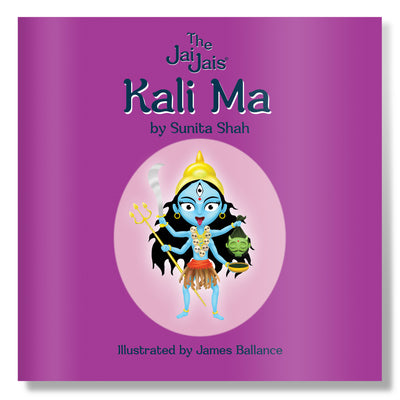Hello! I would like to briefly introduce myself I am Sunita, mum of two wonderful cheeky boys aged 3 and 7 years. I have been a practising Speech and Language Therapist for over 20 years. I am so privileged to have worked with the most amazing and inspiring children and their families.
My love for books has stemmed from childhood, always a book worm and now since moving to tranquil Cheshire loving the time to relax with a good book.
I am super excited to have published 18 books for children of all diversities for children aged between 0-12 years. My series is called “The Jai Jais”, and we have different books for children teaching them about Hindu festivals gods and goddesses. Our amazing illustrator James Balance has brought to life the deities in a modern way to engage children.
Story time and stories are treasured moments in our home, as a child I loved to hear my parents reading and telling us stories. I was always so interested in stories my grandfather, who is 100 years would tell me, great myths and enticing tales of the Hindu deities. Looks like the boys have got my story gene! They love me reading to them daily and their favourite bit is “mummy’s make up stories!”.
We loved using story cards and story cubes to transport ourselves to hidden lands and become who we want to be… imagination is such a wonderful tool to express and create. It’s a shame that in this digital world research has shown that children’s imagination skills are depleting.
I have trained in narrative therapy which is a wonderful tool which I use in my speech and language therapy practise. This is such a wonderful way for children to develop their own story telling skills. It uses a colour coded approach to developing their own stories and include the following components, who, what, where, when, how, the end.
My therapy techniques for story-telling, for reading and creating stories:
Setting:
- Who: Who is in the story?
- When: When does the story take place?
- Where: Where does the story take place?
I will ask these questions as we read a story.
Plot
- What’s the problem?
- How are they going to fix it? What’s the plan?
- Attempt 1
- Attempt 2
- Attempt 3 and so on
The key is to identify the problem with a “what” question. With my older kids, I like to “predict” what is going to happen.
Ending
- What happened at the end?
- How do the characters feel?
Verbal language activities for under fives:
Little ones benefit from visuals when listening to or telling stories since they are just developing vocabulary.
That is why “house or farm” are great oral language development activities.
“Set The Setting” by asking your child these questions:
- Who are you playing with?
- Where is the cow?
- What time of day is it? Morning? Afternoon? Night-time?
Create an Uh-Oh moment! Make a problem (plot) and ask these questions:
- “Look xyz happened”....oh no!
- How does your “character/toys” feel?
Attempts to solve the problem (plot):
- What should they do?
- Let’s try this....
- Let’s try this....
- Let’s try this....it worked!
Ending:
- Problem solved!
- What Happened?
- How do the characters feel?
First, ask your child these questions. Then model a story while you play.
Verbal language activities for over fives:
To target language comprehension, you will work on smaller goals such as:
- Grammar
- Vocabulary
- Story Grammar
- Main idea vs details
- Themes
- Etc...
Writing: Organisation/Planning
Before writing, it is imperative to plan out what you will write. We can help children plan their writing by:
- Using visuals for story grammar components
- Make and practice using graphic organisers
- Teach the skills of main idea and details
- Etc...
Writing: Mechanics
To be a good writer, a child needs to:
- spell,
- write grammatically correct sentences
- use correct grammar
These skills can be developed through writing and speaking.
Spelling
Spelling, yes, spelling! After all, spelling is a language skills. Some ways to target spelling include:
- Working on phonological awareness
- Teach children about morphology
- Practice working memory strategies such as visualisation.
Dialogic Reading
Dialogic reading is basically shared reading. Instead of just reading a book word for word with a child, you make it more of an experience!
Take turns describing pictures and “telling” the story. Ask WH questions, talk about pictures, and relate events to real life.
Narrative Therapy and story telling is key in developing the following skills in your child:
(Ref: Mrs Wordsmith).
-
Vocabulary is key
As far as productive vocabulary of unique word groups is concerned, that is, the words children can use, the typical number of words learned per year can be estimated between 120 and 800 words between the ages of 4 and 12. In terms of receptive vocabulary of unique word groups, that is, the words children understand, the typical number of words learned per year can be estimated as varying between 700 and 1500 words between the ages of 4 and 12.
- Studies have proven that when educational content is worked into strong narrative, children’s vocabulary learning and motivation skyrocket.
-
Nearly everything that a child needs to know in order to flourish academically can be found in books – reading is absolutely the key to knowledge. This is very true, except that children can’t learn what they don’t understand. A research study reports that children deem a text too difficult when they don't know at least 98% of the vocabulary in it. And how much can we rely on the expectation that they will figure out the meaning of unfamiliar words based on the context? According to research, not too much.
A study by Swanborn and de Glopper (1999) found that left to read alone, the average child will spontaneously ‘work out’ the meanings of only 15% of the unfamiliar words they encounter. To put this into perspective, a study by Carver (1994) found that in a typical 12,000 word children’s book, there will be 240 new words, of which an unsupported child will learn just 36 at the first time of reading. The rest will remain a mystery, limiting that child’s understanding and enjoyment of the story.
On the contrary, if children are given definitions of tricky words they encounter, the percentage of new words being understood and learned could increase from 15% to 37% .This suggests that additional information about unfamiliar words can really make a difference and reveals the vital need for direct vocabulary instruction.
- Increase of expressive language.
- Increase in attention/listening skills
- Psychological Reasons A child who learns to read joyfully at home, at an early age, with a loving parent or caregiver, grows in self-confidence and independence.
- Developing imagination.
- Develops empathy.
- Improves writing skills.
- Reading helps to develop a young child's brain. In the first six years, children learn at a much faster pace than at any other time in their lives.
- Every child loves spending time with their parents and enjoys listening to them and interacting with them.
- It is never too early to start sharing books with your child, even as young babies they enjoy, and will learn from, hearing stories and looking at books.
- Research shows that reading at home with their child is the single most important thing a parent can do to help their child’s education.
Mostly importantly have fun and enjoy those special moments of story-telling with your child.
For some fun reads for children aged 0-12 years find us as: www.thejaijais.com













